People purchase insurance to protect against the financial loss of a contingent event. Every insurance policy has an identifiable risk and premium, or cost, associated with it. For example, a working parent purchases a $1 million 10-year term life insurance policy in order to support her surviving spouse and children in the event of her death. The premium is $100 per month. This QV Update examines portfolio risks through the lens of insurance.
CONVENTIONAL WAY OF VIEWING PORTFOLIO RISK
Many events have temporarily derailed equity markets over the past century, and indeed many potential threats, such as political uncertainty, macroeconomic shocks and trade wars, exist today. Even when the damage to markets has been significant, they have always recovered in time. Fear is a risk to wealth accumulation because investors often overreact to the never-ending stream of worrying news by selling into fear-induced volatility.
Insurance: A good defense against fear is to have a well-balanced portfolio that can absorb day-to-day and year-to-year volatility in asset prices. A balanced portfolio of stocks and bonds ensures that you never experience the worst-case scenario in markets.
Premium: The cost of this insurance is that you will also never get the best-case scenario, which could very well be a 100% allocation to stocks over the long term.
ALTERNATIVE VIEW OF PORTFOLIO RISK
We ordinarily think of insurance as something we need in order to mitigate the financial consequences of a bad outcome. Instead of focusing on the fear of volatility, we could turn the situation on its head and consider the risk of being unprepared to benefit from a positive outcome. Along with the general arc of human progress, stocks have steadily risen over long periods of time. So, although the bumps along the way make stocks appear risky, without them, a portfolio will not be positioned for success if the arc of progress continues.
In today’s environment, “high interest” savings accounts or 100% bond portfolios are risky for long-term investors, despite their low volatility. Consider that for someone entering the workforce today, an appropriate savings target to meet long-term objectives might be 10-15% of pay if invested in a balanced portfolio. However, the same individual would have to increase their savings target to 25-30% of pay if invested conservatively in bonds.
Insurance: A good defense against the world steadily improving is to hold the things that will go up in value in line with human and economic progress. In this sense, stocks can be considered as a hedge against the financial risks of success. It’s a different way of thinking, but it could provide investors with a more balanced view of risk.
Premium: Bearing the psychological toll of stock market volatility is the premium an investor must pay to ensure they have the wealth to fund a long and happy retirement.
THE RISK OF AN INVESTOR OUTLIVING THEIR WEALTH
Individuals face considerable mortality/longevity risk due to the uncertainty of whether they will die young or live to be 100 years old. In Canada, retired workers receive lifetime income from the Canada Pension Plan (CPP) at age 65 in proportion to their contributions to the program (reduced pensions are available as early as age 60). Canadians also receive a pension from Old Age Security (OAS) at age 65 in proportion to their years lived in Canada.
Insurance: Under both programs, benefits can be deferred by up to five years, with CPP increased by 42% and OAS by 36% at age 70. For individuals entitled to the maximums from both plans, this can be the difference between receiving $21,500 at age 65 or $30,000 starting at age 70 (using 2020 benefit levels). Under this scenario, a person who lives to 100 would receive an additional $150,000 (or more) by deferring government pensions to age 70. Conventional advice encourages people to take government benefits as soon as possible. While that might be optimal for many Canadians, delaying benefits from CPP and OAS can be a great way to hedge the financial risks of a long life.
Premium: There is psychological discomfort associated with passing up government benefits at first eligibility. Furthermore, there is no guarantee that government programs won’t be amended to your disadvantage during the deferral period.
Investors benefit from having many mental models at their disposal to navigate various scenarios. We hope the insurance mental model combined with unconventional thinking will help guide you to financial success.




